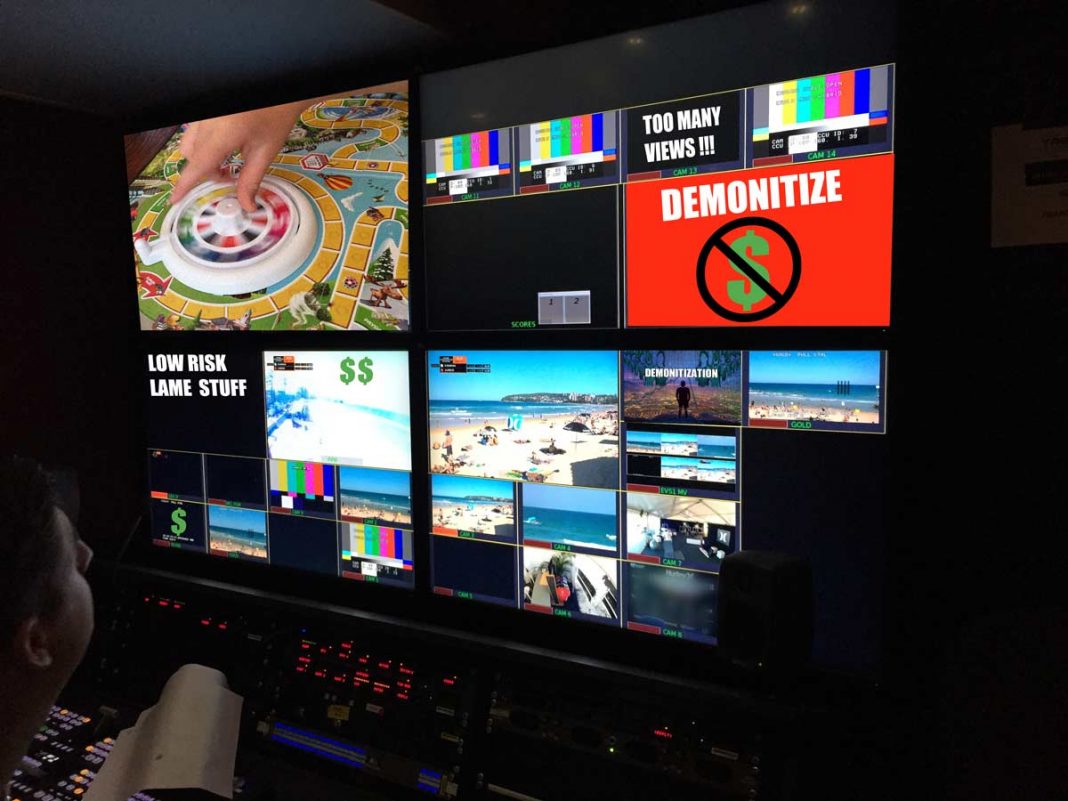What if YouTube Demonetization really didn’t happen the way most YouTubers believe it did? What if something else happened, something that YouTubers who were demonetized have pretty much avoided considering? I’ll reveal a little theory on what I think might have happened that resulted in so many YouTube channels suddenly earning less money.
DISCLAIMER
I’m not insisting this theory is an accurate and absolute reflection, because I cannot pry open all the black boxes. Nor am I asserting that every outcome was driven by intentful, planned decision making. What I am offering is a reminder of what the players involved have to gain or lose. You’re free to draw your own conclusions about the subject and whether you differ or agree. I invite you to share your thoughts about it in the comments I moderate below.
What was YouTube Demonetization?
Over the last decade many “internet personalities” have earned considerable revenue from their YouTube channels. This is because YouTube gives the content producers a decent portion of the ad revenue their channels generate. If the videos are popular YouTube can show tons of ads on the channel and make both advertisers and the channel producers very happy. Viewers got more choice than ever to watch what they want, with advertisers and “garage” content producers all being made happy simultaneously, is what makes YouTube a wonderful thing that stood apart from the traditional media channels that came before it.
Initially YouTube was filled with alternate ideas – ideas that viewers could find on YouTube that television wasn’t offering. The ability to control exactly what YOU requested allowed certain channels to succeed based on quality and appeal to the viewership. If a viewer wanted pseudoscience, satire, alternative views and especially to hear extreme views from the people who believed them the most, they could get it upon request from YouTube. Many channels nurtured large audiences because they occupied alternate niches. Things that wouldn’t work in traditional broadcast formats, things unable to attract a large enough audience or appeal to a local audience enough, found enough of an audience to encourage content creators to keep producing.
How View Count Matters The Most
Getting views is the metric of merit, and the more meritorious something is, the more it gets rewarded in a way that the audience and content producer immediately recognize: the view count.
Alongside people opening YouTube with the intent to find a video on something specific, there’s an audience who sticks around. The videos that YouTube plays automatically get super-valuable exposure to new audiences. Content producers really really benefit from the exposure that comes from automatic plays and YouTube’s promoting their videos to new YouTube viewers on the viewer’s personalized home page “suggestions”.
Viewers subscribe to the channels of the content producers who’ve produced videos they like. They watch the videos that YouTube automatically plays after the video they requested finishes. They visit the YouTube homepage to discover what’s new. A combination of algorithm and human moderation has always been responsible for what get exposed to viewers, auto played, or suggested.
YouTube has always depended on moderators, people who work removing content like porn, calls to action for violence, threats and blatant unabashed hate speech.
Channels promoting unpopular ideas, using controversial tactics to make statements, risk becoming “unboosted” or censored. They might not be removed from YouTube, but instead their degree to which their videos are automatically shown to new viewers is, in some cases, totally diminished. The increasing views these controversial content producers once counted on suddenly becomes a trickle of views when this happens. Even channel subscribers may not have the video suggested to them. Content producers whose content fell “over the edge” also saw decreases in the payouts they were getting from YouTube as a result.
Loosing the Boost After You’d Had It Feels A Lot Like Censorship
Last year, in 2018, Nasim Aghdam, a YouTuber who produced exercise videos was so upset over the drop in her income from YouTube that she drove to the YouTube headquarters, shoot three people and then took her own life. She had made some statements on her channel about animal rights and done some unusual things on her videos in an effort to get more attention. Afterwards she noticed a drop in her views. She believed YouTube was intentionally censoring her, singling her out and exposing her videos to viewers less because of her animal rights stance.
In 2019 we saw a sea change in YouTube’s relationship with many of its content producers as a whole. Sufficient numbers of content producers were seeing changes in how their channels made money that it gained a name for it emerged separate from “censorship”. This is was the beginning of the phenomenon now referred to as “demonetization.”
Demonetization Lore
Here’s the public relations lore around “demonetizatrion:” that was spread at the time.
Mainstream media sources all reported in unison how major advertisers, popular brands with big budgets, made an appeal to YouTube. They demanded YouTube be more restrictive where their ads were shown, citing controversial channels as ones that could reflect poorly on the brands. A collective “boycott” of YouTube spurred the need for more safety.
In March of 2019 YouTube sent a shot over it’s bow and sunk conservative commentator Alex Jones’ content and branded channels, banning any videos containing him, even if they were on other channels.
YouTube’s most popular personality and channel at the time, “Pewdiepie“, a young man who mostly reviews video games, had made a series of incredibly insensitive anti-semetic blunders, proving that you don’t have to be a genius to be the most successful social media earner. He defended his actions as “being extreme for attention”, and payed the price for pushing the envelope over the edge of hurtfulness.
Both of these two personalities capitalized on “being outrageous”, but unfortunately it wasn’t tempered enough to not effect all other YouTube producers. A ripple shot through the industry and type of collective punishment began. This ongoing “punishment” of content creators, now referred to as “YouTube Demonetization”, involves ads being restricted, not shown on videos that YouTube’s heightened discretion deems too controversial for advertising.
Conservative voices have collectively stated that this effort by YouTube to mistreat its content producers is unfairly more targeted at them. It feels personal when it impacts you. However, it’s not only conservatives who are crying poverty due to the lack of access to their audience. Even popular YouTubers who identify as progressive and liberal, like Tim Pool, have to be careful about words they use, especially in video titles. Using the wrong words or focusing on the wrong subject means ads won’t be shown on videos.
Demonetization still is a wide spread phenomenon. As the tide went out so many boats fell at the same time. The channel didn’t have to be about politics or very controversial topics. Channels that were about fringe subjects like archaeology and UFOs also saw drops in their channel’s subscribers and views.
Who’s To Blame for Demonetization: Content Producers, Advertisers or YouTube?
Of course YouTube has to blame it’s content producers for being too edgy, for crossing the line. Ironically this is the same kind of behavior that’s great a getting attention that translates into views. Advertisers are happy to join in with YouTube and insist that certain poster boys of edginess are made examples of. It’s a show. It’s art. Of course they can’t resist telling that story. It not only excuses them from blame, it makes the product they’re still going to depend on seem more appealing to it’s audience, especially younger people.
Most YouTubers buy into the collective lore and accept that the reason they aren’t as rich as they expected to be, compared to what they expected a few years ago, is on account of YouTube’s succumbing to advertiser pressure. They blame risk-adverse, cautious marketing departments, fearful for their brand’s associations, as the reason for their drop in revenue. It’s understandable why a lot of people believe that. That’s what YouTubers were told to believe and what they’re conditioned to believe day after day as certain videos that still cross lines won’t have advertising placed on them. YouTubers are told those videos aren’t making YouTube any money, and therefore that they shouldn’t expect compensation from this. YouTube is being technically correct while at the same time entirely dishonest to it’s most valuable audience. I will explain what I mean by this in my next article.
Some YouTubers blame YouTube. Channel owners feel like YouTube pulled a “bait-and-switch” on them, enticing them to build content and audiences, only to reject all that accrued value in an effort to appease advertisers. They feel a bitterness towards YouTube. Many feel like the whole of their contribution, the benefit they’ve contributed to YouTube because they produced content for it, isn’t reciprocated. My next article will explain why content producers whose demonetized videos are getting views might not realize they’re YouTube’s most valuable asset and they’re accepting getting screwed.
It’s understandable why content producers feel upset that investment and risk diving into their new career paths as a YouTuber isn’t reciprocated. One day a giant corporation is sending you signals that they value you, and that you can quit your day job. The next that corporation is diminishing the offer by 80%.
To be fair, the great majority of YouTubers had any contracts or commitments from YouTube, but content creators were counting their revenue into the future, thinking that their earnings from YouTube would only continue to grow and never shrink. They thought things would stay the same. But they didn’t.
Being a YouTuber Still Pays in 2019
Kids are no longer saying they want to be doctors and lawyers, firemen and police. Kids are openly declaring “YouTuber” as what they want to be when they grow up.
But hold on kids…. don’t get all “2018” on us.
Being a successful YouTube personality all of a sudden means making a whole lot less now in 2019.
That’s the official story of demonetization.
Let’s look beyond that and read between the lines. Let’s get real.
Demonetization Reality
What if a lot of that official Demonetization Lore is B.S.?
What if it’s all been a whole lot of smoke and mirrors from the same folks who brought us show business in the first place?
What’s the (more) real story?
The media industry is undergoing a period of transition between technologies. There are certain companies and brands, powerful well capitalized people, who have their fortunes tied to old technology while others have tethered themselves to the new. FANG (Facebook, Amazon, Netflix, Google) emerged and with it the world’s new top billionaires. Not only did these new technologies bring their owners and operators fantastic new wealth, but they also, in themselves, afford unprecedented powers. New levels of control were perfected, blurring the lines between the programmers and the programmed, the broadcasters and their audience.
New Dimensions of Advertising Opened Up. Investors saw the enormous differences between advertising on traditional channels and putting money online. This resulted in giant capitalization for these new online companies. But what about audiences? What about the market who follows them: advertisers?
Would advertisers buy into an empty platform, start producing content for it, start shifting their buying habits over to it as fast?
No. Not really.
Investors can make decisions quickly but audiences take time to build. The investment market for online technologies wasn’t going to wait around for that painful reality. It wasn’t good enough to have a technology beyond all the competition, a technology with enormous potential. That potential alone isn’t enough.
There needed to be audiences, rapidly growing audiences, for technologies to signal how successful they were. Numbers of viewers mattered more than anything because this way to measure success is common between traditional media and online media. Even though apples are different than oranges they’re still being sold to the same market. There’s still a competition.
Content producers trickled onto YouTube initially, experimenting with it as a platform, producing its first videos. An organic flow of viewer traffic, characterized by first adopters, performed the first merit based choices. YouTube viewers subscribed to content producer’s channels in order to be informed about their new videos.
YouTube programmers and engineers were faced with a chicken-and-the-egg problem. Left alone it might take decades for a platform like that to reach it’s potential, for great channels to build great audiences. It would take time to build audiences large enough for content production to at least pay for itself. Left alone there was a great chance it might never succeed in the manner it should, in the way it could. Great content producers had come and gone already trying to stay sincere
Remember that YouTube programmers and engineers, in the top tech company on the planet, Google’s best people, aren’t operating in a vacuum. They have other online video phenomenon to compete with as well as competing against traditional on-air channels for eyeballs.
This is where the need for “artistry” came in. The technologies best at “faking it” were going to be the ones on top and ultimately the few that survived.
Fake It Til You Make It
(then you don’t have to fake it any more) <- “demonetization” ???
So what about a kick start? What about some “initial exaggeration”? What’s wrong with a little showmanship to make something look just a little better than the competition, especially if the competition are doing it too?
Does a platform have to do the faking itself to make numbers appear that don’t match the number of real users, real viewers?
No. Not Really. Not at all. There are bots waiting who will do that, if they’re allowed to.
All a platform needs to do is be a little less picky about who gets counted. The blurry line between a real person using an app on their phone and a bot hired out per click to be a shill just has to be moved back a bit, have the counting mechanism be a little less careful. More bots will get counted as people.
Using shills is a tactic that’s as old as the need to draw a crowd. Record labels use them. Politicians use them. Anyone who has to be judged against their competition on the basis of popularity can benefit from the use of “shills” to pump up their numbers. These hired shills are lose on the Internet right now, clicking on things sometimes right before you did, sometimes right after. They’re out there doing it creating a digital trail for themselves in an effort to look as much like a real person as they can, liking all sorts of things, clicking on all sorts of things, watching all sorts of videos – just like you. A bot acting as a shill can’t do just one thing if it’s going to get away with it. It has to do a hundred other stupid things too, so the one thing it was intended to do looks like a person did it.
Being lenient with shill bots on your networks and platforms create hundreds of views (that look just like people).
Using shills is not necessarily something people would call ethical, and there are some laws against it, like payola laws for the radio industry. This doesn’t stop it from being used online today. Platform publishers are among the list of audience dependent people who can benefit a lot from employing shills. At a minimum they’ll recognize how others take advantage of them and create ecosystems where the behavior benefit the platform indirectly in different ways instead of hurting it. I discovered, first hand, where Facebook was scamming their advertisers, including me, by being neglectfully lenient with bots. Not only were they doing it, they had a feature active at the time that revealed the scam openly. Since that feature has been removed, and multiple suits have been brought against Facebook for doing similar things.
At the time when I discovered Facebook’s fishy behavior towards their advertisers, Google was still telling their employees “Don’t be Evil.” Based on my interactions with Google versus Facebook, as a marketer, as an advertiser, I had accrued more faith in Google. In the simplest sense, advertising on Google delivered a better return on investment than on Facebook, at least for me. As an advertiser it’s hard for anything else to be as important than ROI. Google wasn’t evil or dishonest with me. I trusted Google more.
Since, the warning “Don’t be evil” has been removed from the Google Code of Conduct.
Google engineers aren’t just able to do everything they need to do in a virtual black box, concealed from all their stakeholders, viewer and advertiser alike. They’re also sitting on enormous amounts of investment, ad income and their product/service is implicitly cheap to produce: information. They’re not even producing the information and content – they’re just the ones collecting the money around it – the broker – the middleman.
Not kick starting this amazing platform, when you’re responsible for its survival, under those conditions would be negligent. Neglecting to do a little artistry with the numbers might make the next great content production sources fade into nothing like Pseudo.com did. They weren’t bad. That was sad. There’s many other great content producer brands that came and went before 2000. YouTube couldn’t let it happen to them. There was no way they couldn’t have considered, or dabbled in, “kick starting it”.
What exactly do I mean by “kick starting” it?
Here’s what I mean:
Essentially “exaggerate” views to content creators. A little “pretend” to them creates the sizzle. It gets the rate of content creation accelerated. It fills the content library. Not much needed to be done. Few people would need to know about it.
They faked it.
Institute a “proprietary” program temporarily, one that gives content creators artificial income. If their channel only has 50,000 subscribers and they’re making only $50 a day from their videos, encourage them extra, beyond reality. Tell them they have 250,000 subscribers and give them $500 a day instead. Give them some artificial motivation so their next video is published faster.
Why would YouTube do this, and waste so much money faking out content creators? Just to fill up their content libraries faster? It’s not that simple. The most important reason was more immediate, a layer under that: advertisers were watching. Advertisers were experimenting with being content creators too. For advertisers to see that their ads were going to genuinely reach audiences they needed to see content creators genuinely being paid.
An advertiser isn’t going to go through the effort of setting up an ad campaign for an empty audience. An advertiser is going to look at whether the channels they’re considering placing ads on are making money or not, whether there’s really an audience worth reaching there.
Til they made it.
Advertisers had their own experiences that matched content producer’s testimony about their revenue earned on YouTube. YouTubers weren’t hiding what they made, they were bragging about it and using it as the reason to justify more videos. It’s not unrealistic to refer to that time as the Golden Age for being a YouTuber.
The problem with some artificial stimulus, just like this artificial “kick start”, is that they can’t go on forever. Audiences get smart. The things that worked yesterday don’t work as well today. The problem with advertisers in 2019 is that they know apples from oranges. Fake audiences, fake subscribers and bots clicking on links do not produce revenue. Only real audiences do.
If this practice of paying content producers artificially was going on, it couldn’t go on forever.
Then they didn’t have to fake it any more.
Savvy advertisers, big brands with big budgets, have the means to do click attribution and see who is sending the traffic that ends up in conversions, real sales. Advertisers who see poor conversion performance coming from channels will reduce their spends on those channels proportionately.
It’s no wonder big brand advertisers collectively approached YouTube. It’s easier, in some ways to believe they were concerned about the ad value they were getting from the channel than the stigma of being associated with controversial videos, videos effective at drawing bigger audiences.
Demonetization had to occur at some point, but it didn’t make sense to happen until that critical threshold of getting enough content and enough advertisers was reached. There’s no doubt advertisers and YouTube see value in each other, but the relationship is, at the end of the day, measurable and measured in sales against competing channels.
Would YouTube have been as dominant if they didn’t exaggerate?
Were content producers uploading as much content to Vimeo, a free streaming video platform that essentially offered it’s content producers the same technological abilities at the same price, free? Do people remember who started all this streaming video in the first place: RealNetworks?
No, No, and No.
Is that a bad thing though?
Maybe it’s a little dishonest for them to do that, but I love YouTube.
I love having the content there, I love having the technology to select it and add to it if I so choose.
I especially love the effort that content producers have put into making content that I enjoy, niche content, stuff that would be a hard sell to create a “show” around, even on local cable.
Even if there was a little fantasy, a little fiction, perpetrated, exploiting people with a need to seen, and addiction to being expletive, it motivated people to start something wonderful. If ever there was a damned virtuous lie, this was it.
Is it Bad for Google to Be Evil if the End Result is Good?
If you’re a YouTube fan and you’ve been watching YouTube videos since YouTube began you’re probably like me. You probably remember back when the ads that played on YouTube were nothing but repetitious. The same ad would play over and over, after every video. It was a really annoying part of watching YouTube. I used to laugh about what they’d have to show as ads, poorly targeted at me and with so little diversity. The same ads, over and over, for weeks some times.
Now it’s very different. The change in ads happened about the same time. All of a sudden YouTube had to get their acts together. Audiences are now getting a lot of different ads shown to them, a lot more diversity in the ads being shown, and the ads seem more intelligently targeted.
YouTube is sending off more powerful signals that the effectiveness of their advertising is now more important than before. The online advertising ecosystem around video has grown up and is less in need of smoke and mirrors. It’s training wheels have come off and it’s on a more self-sustainable course. It got the boost it needed while it was maturing, but now it’s all grown up. Demonetization is simply real, sustainable monetization’s feet landing on the ground.
There’s Still a Lot of Supply Relative to Demand
The post-demonetization world has fewer ad views being show, more videos being published with no ads on them whatsoever. It’s a less easy world for YouTube content generators to build careers around. But this doesn’t mean it’s not possible. This doesn’t mean people won’t produce content – it just means the content that does get produced will result in less compensation. Now it’s a more real competition. That’s a great thing. It means better quality for everyone.
That’s one plausible explanation, the one that makes the most sense to me seen through the lens of my experiences. What do you think?
Read the next article I wrote after this one. I talk about how YouTube still makes money off demonetized videos yet treats the content creators as if they’re doing something unprofitable.














